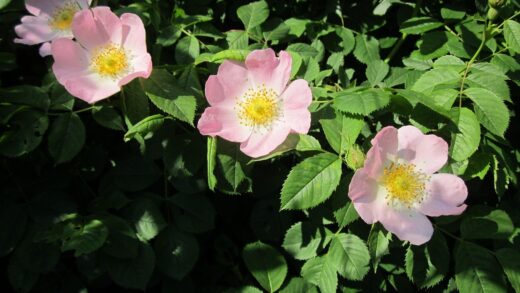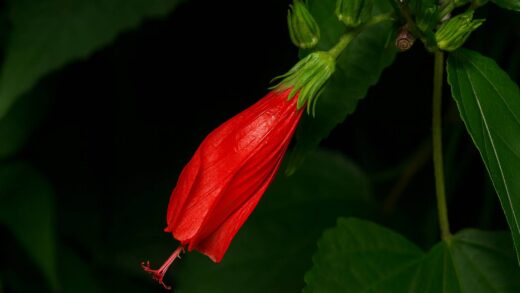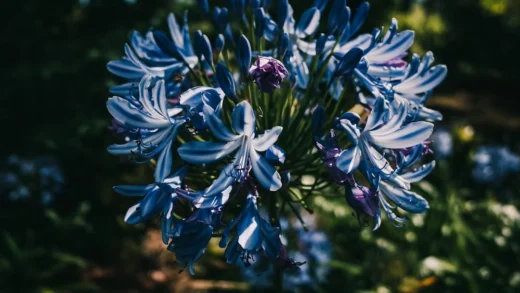Fuchsia, this enchanting ornamental plant with magnificent flowers, loved by many, can adorn our garden or home for a long time with proper care. One of the fundamental conditions for abundant flowering and healthy, vigorous growth is a precise knowledge of the plant’s light requirements and their satisfaction. Many misconceptions circulate about the light preferences of fuchsias, which is why it is worth exploring this topic more thoroughly so that our plants feel as good as possible. An insufficient amount of light, indeed, can easily lead to the plant languishing, susceptibility to diseases, and a lack of flowering, which can be frustrating for any garden enthusiast. Precisely for this reason, it is crucial to understand exactly what light conditions these wonderful plants prefer.
Light conditions in the fuchsia’s natural habitat
The Fuchsia genus is very extensive, and most of its species originate from mountainous and forested regions of Central and South America, as well as New Zealand and Tahiti. A characteristic feature of these habitats is filtered sunlight, where the canopies of taller trees provide natural protection against direct, scorching sun rays. In tropical and subtropical high mountains, fog and humid air are common, which also affects the intensity and quality of light. These conditions have shaped the fuchsia’s adaptation to light, which also determines its cultivation requirements.
In its natural environment, the fuchsia often grows as an understory plant or in the shrub layer, where sunlight reaches it only sporadically, in patches. It may receive morning or late afternoon sun with lesser intensity, but it is protected from the strong midday sun. This type of “dappled shade” provides it with the necessary energy for photosynthesis without the risk of leaf burn or overheating of the plant. The soil in these locations is usually moist, well-drained, and rich in nutrients, which also contributes to the healthy development of the plants.
Understanding the original habitats helps us to create similar conditions for them in our garden or apartment. It is no coincidence that fuchsias often feel better near an east or west-facing window or in a more sheltered, semi-shaded corner of the garden. Most fuchsia species and hybrids tolerate direct sun poorly, especially during the summer months. Therefore, one of the secrets to successful cultivation is to take these natural needs into account.
In addition to light conditions, the climate of the habitat, temperature, and air humidity also play an important role. Fuchsias generally prefer cooler and more humid environments, which is also related to the fact that they avoid direct sun. The combination of high temperature and strong sunlight can be particularly stressful for them, which can lead to leaf drop and reduced flowering. Therefore, when discussing light requirements, it is always necessary to consider environmental factors comprehensively.
More articles on this topic
The key to successful cultivation: optimal light quantity
Ensuring the ideal amount of light for fuchsias is essential for abundant flowering and maintaining healthy foliage. Generally, it can be said that most fuchsias prefer bright but filtered light, or direct morning and late afternoon sun. However, they must absolutely be protected from the scorching midday sun rays, as this can easily lead to leaf burn and general weakening of the plant. In a well-chosen location, the plant can gather enough energy for photosynthesis without being subjected to stress.
The term “semi-shade” often leads to misunderstandings; in the case of fuchsias, this does not mean deep shade where the plant barely receives light. Rather, it designates a place where the plant is exposed to direct sun for a few hours a day, usually during periods of less intense radiation, while the rest of the day it receives bright, indirect light. For example, an east-facing balcony or windowsill, where they receive a few hours of sun in the morning, can be ideal for them. In the case of a west-facing orientation, attention must be paid to the strength of the afternoon sun, especially in summer.
In addition to light intensity, the duration of illumination is also an important factor. Fuchsias are generally long-day plants, which means that for flower formation they need illumination longer than a certain number of hours. In natural conditions, this occurs in spring and summer. In the absence of a sufficient amount of light, the plant can become leggy, its leaves can become smaller and lighter in color, and flowering may be absent or sparse.
When placing the plant, it is worth observing how it reacts to the light conditions of the chosen location. If the leaves start to turn yellow but do not burn, and the growth is weak, this may indicate a lack of light. If the edges of the leaves turn brown, dry out, or burn marks appear on the leaves, this is probably the result of too much direct sunlight. Observing the plant’s reactions helps to fine-tune its placement and find the optimal balance.
More articles on this topic
When sunlight is excessive: burns and other symptoms
Fuchsias are sensitive plants, and excessive, direct sunlight can cause them serious damage. One of the most common and visible symptoms is leaf burn, where dry, brown, or whitish, sharply demarcated spots appear on the leaves. This can be observed especially on leaves exposed to the strongest midday sun and significantly reduces the plant’s photosynthetic capacity. Burns are not only an aesthetic problem but also negatively affect the overall health of the plant.
In addition to leaf burn, excessive sunlight can also cause other symptoms. The edges of the leaves can turn brown and dry out, the plant can start to wilt even if its soil is moist because the rate of evaporation exceeds water absorption. In such cases, the plant, as a defense mechanism, may drop its leaves and flowers to reduce the evaporation surface and conserve moisture. The color of the flowers may fade, and their lifespan may be shortened due to excessive heat and light load.
It is important to note that freshly repotted, young, or diseased fuchsias are particularly sensitive to sunburn. These plants must be gradually acclimated to stronger light conditions if they are moved to a new location. A sudden environmental change, for example, moving from the overwintering location to the spring sun, can also cause shock if proper acclimation is not carried out. In such cases, it is advisable to first place them in a shadier spot and then daily increase the duration of exposure to direct sunlight.
Under the influence of stress caused by excessive sunlight, fuchsias can also become more susceptible to various pests and diseases. The immune system of a weakened plant can defend itself less effectively, for example, against spider mites, aphids, or fungal infections. Therefore, for preventive reasons, it is also extremely important to protect fuchsias from direct sun and provide them with ideal, filtered light or semi-shade.
The dark sides of light deficiency: weak growth and lack of flowering
While excessive sunlight can damage fuchsias, a lack of light is just as unfavorable for the plant’s development. An insufficient amount of light hinders photosynthesis, which is the plant’s fundamental energy source. As a result, growth slows down, the shoots elongate, become thin and weak – this phenomenon is called etiolation. The plant then desperately tries to reach towards the light source, which can lead to a distorted, disproportionate shape.
One of the most obvious signs of light deficiency is the change in the condition of the leaves. The leaves may remain smaller than normal, their color may become pale green, even yellowish due to a lack of chlorophyll. The lower leaves may fall prematurely because the plant concentrates the little available energy on the development of newer shoots closer to the light. This leaf loss further weakens the plant and reduces its ornamental value.
From the point of view of flowering, light deficiency is a particularly critical factor. For abundant flowering, fuchsias need a sufficient amount of light energy for the formation and development of flower buds. In conditions of light deficiency, flowering is either completely absent, or only a few small, insignificant flowers develop. If the plant still blooms, the color of the flowers may be paler, and they may wilt more quickly. Therefore, if our fuchsia does not bloom, one of the first things to check is to ensure a sufficient amount of light.
Prolonged light deficiency not only slows down growth and flowering but also reduces the plant’s overall resistance. A fuchsia suffering from a lack of light is much more susceptible to various diseases, for example, fungal infections, as well as pest attacks. Weak tissues constitute an easier target, and the plant does not have enough energy to defend itself. Therefore, to maintain the health of fuchsias, it is essential to provide them with an optimal, bright, but not directly sunny location.
Differences in light requirements according to varieties and developmental stages
Although it can generally be said that fuchsias prefer filtered light, it is important to know that the light requirements of different varieties and hybrids can vary slightly. Some varieties, especially those with darker colored flowers or leaves, may be more tolerant of sunnier conditions, while varieties with lighter colored flowers or variegated leaves are often more sensitive to direct sunlight. When buying or choosing a variety, it is advisable to inquire about the specific needs of the respective cultivar.
Fuchsias with small leaves and small flowers, often grown as standards (small trees), such as Fuchsia microphylla or Fuchsia magellanica and their hybrids, generally tolerate the sun better than large-flowered, trailing varieties. This is partly due to the peculiarities of their original habitats. However, even these more sun-tolerant varieties do not like the scorching midday sun, especially in hot, dry climates. The safest combination is always morning sun and afternoon shade.
The developmental stage of the plant also influences its light requirements. Young, freshly rooted cuttings, or seedlings are much more sensitive to light than already developed, strengthened specimens. For them, a bright but completely shaded place must be ensured until they strengthen. Plants taken out from overwintering in spring must also be gradually acclimated to more light to avoid leaf burn and shock to the plant.
During the flowering period, fuchsias need abundant but not scorching light for continuous flower formation. If the plant is actively growing and flowering but is suddenly moved to a shadier place, flowering may cease, and the buds may drop. Precisely for this reason, it is important to provide them with stable, optimal light conditions during the growing season, taking into account the needs of the specific variety and the current condition of the plant. Careful care is rewarded with abundant flowering.
Managing light conditions: practical tips for indoors and outdoors
For the successful cultivation of fuchsias, conscious management of light conditions is essential, whether they are kept indoors or outdoors. Outdoors, the most important thing is choosing the right location. Ideal are those parts of the garden or balconies that receive morning sun but are in the shade during the midday hours. Such a place can be provided by an east-facing wall, filtered light through the canopies of larger plants or trees, or a properly positioned pergola. If only a sunnier location is available, the intensity of direct sunlight can be reduced by using shade netting.
For fuchsias in pots, mobility is a great advantage. The plants can be easily moved with the change of seasons and times of the day, always ensuring optimal light conditions for them. In midsummer, when the sun’s power is strongest, it might be wise to move them to a completely shaded but bright place, while in spring and autumn they can receive more direct sun. Care must be taken that the pots, especially dark-colored ones, do not easily overheat in the sun, which can lead to root damage, so this must also be taken into account when placing them.
When growing fuchsias indoors, choose the brightest windowsill, but here too, avoid the direct, scorching sun of south-facing windows, especially in summer. An east or west-facing window usually provides sufficient light. If only a south-facing window is available, use a thin curtain or blinds to filter the light. During the winter months, when the amount and intensity of natural light decrease, supplementary lighting may be necessary, especially if one wishes to keep the plant in active growth or promote flowering.
In addition to optimizing light conditions, let us not forget other environmental factors such as adequate temperature, air humidity, and watering, as they are closely related to light requirements. For example, a fuchsia kept in a sunnier location requires more water, and due to the higher temperature, more attention must also be paid to air humidity. Regular observation of the plants and coordination of environmental factors are the key to growing healthy and flowering fuchsias.




















